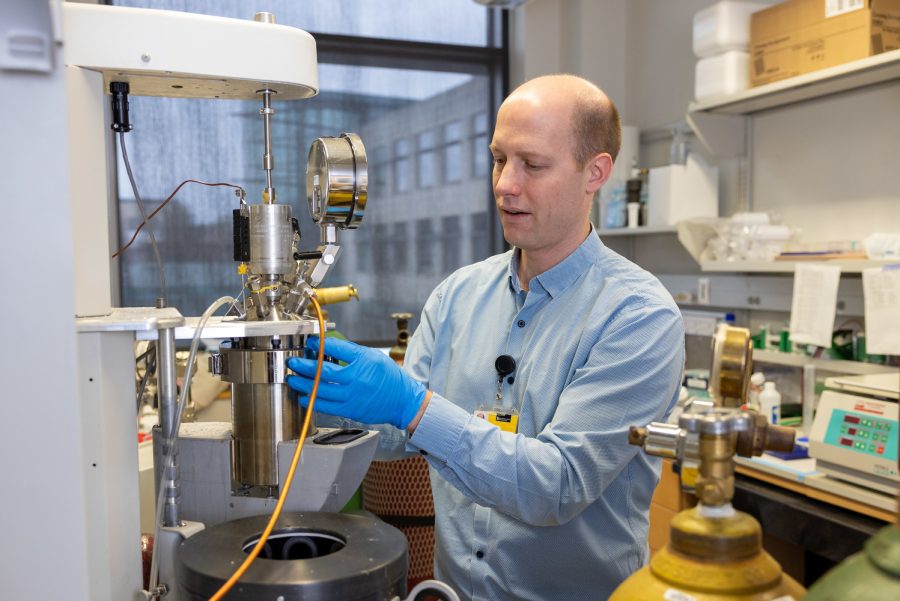New UI cancer research inspired by latte foam
UI researchers are using culinary arts techniques to create new therapeutic materials that can improve the effectiveness of chemotherapy and radiation.
Liz Martin – Photographer – University of Iowa Health Care
James Byrne with his lab’s Parr high-pressure stirring reactor on Friday, Jan. 27, 2023. A paper published in February 2023 in Advanced Science (IF 17.5) focused on the use of molecular gastronomical techniques to create novel materials for the treatment for cancer.
Sofia Mamakos, News Reporter
February 19, 2023
Researchers at the University of Iowa found inspiration from the same bubbly foam found on a morning latte to improve the effectiveness of cancer treatments.
In a new study published Feb. 2 in the journal Advanced Science, researchers used gas entrapping materials, which are materials they designed to carry high concentrations of gasses directly into tissues and tumors and can be formed as foams, solids, or hydrogels, to enhance therapies and slow tumor growth in mice.
Leo Otterbein, a contributor of the research from Beth Israel Deaconess Medical Center in Boston, said the techniques used in the study were a relatively uncomplicated process.
“It’s such a simple concept that you can put gas into these foams, and the foams themselves are things that you’d find in restaurants or in the grocery store,” Otterbein said.
The researchers reverse-engineered a whipping siphon — a device commonly used by baristas to create foam with nitrous oxide — to construct the foam gas entrapping materials with oxygen instead.
James Byrne, UI assistant professor of radiation oncology and senior author of the study, said it consisted of creating a new, unique material based on the intersection and conversions of the field of medicine and the culinary arts.
“These are really simple, really safe materials that you can actually find within lots of foods and various pharmaceuticals, and so they’re very, very translational,” he said.
Translational is a word used to describe methods that easily can be converted from mice model testing to research on humans.
RELATED: UI student beats cancer, enjoys remission as a Hawkeye
Researchers tested the material on prostate cancer and types of sarcoma in mouse models. They found that when combined with radiation and chemotherapy, the materials they implanted had a huge effect in slowing tumor growth.
“We saw profound slowing of tumor growth within two different animal models of cancer,” Byrne said. “Not only that, we also saw a change within the tumor environment.”
Byrne said cancer oncology treatments have recently focused on looking at the tumor microenvironment.
“We know these tumors are very hypoxic, which means that they have low oxygen levels,” Byrne said. “That infiltrates really every part of cancer and cancer therapies. We saw that by just having more oxygen there, we were changing that environment to make it more conducive and responsive to even immunotherapies.”
Otterbein agreed that, along with therapy, adding oxygen in this way can help eliminate the tumors.
“By injecting this into tumors, he provides a benefit by essentially creating a tumor that is usually hypoxic or low oxygen, and he gives it a burst of oxygen that it normally doesn’t see,” Otterbein said. “That’s a benefit to the body by helping eliminate the tumor, and you combine that with radiation, and you get an even better effect.”
Emily Witt, a contributing author of the study, wrote in an email to The Daily Iowan that the research aimed to increase oxygen levels in cancerous tumors to someday have a positive impact on patient outcomes.
“We found that injecting or implanting the [gas entrapping materials] into tumors can mitigate tumor hypoxia by delivering oxygen locally,” Witt wrote.
Byrne said the GeMs were able to enhance responsiveness to radiation and chemotherapy in multiple tumor types and improve the management of tumors that are treatment-resistant in standard therapies.
“There are some really non-responsive tumors out there that continue to grow despite being on maximal therapies, and so we thought that we could provide a big benefit there,” he said.
Because the study is only preclinical, the next step in this research is to create a safe and deliverable material to human patients.
“I want to see this trend translated to patient care,” Byrne said. “Again, these are very, very translational materials that I think would be a nice fit and, hopefully, easy to move into clinical trials.”



